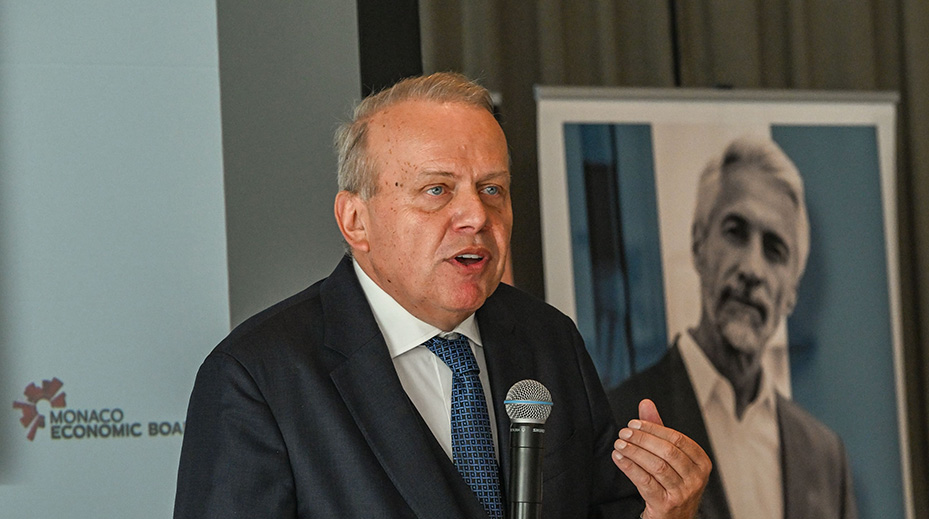
Jean-Pierre Petit, President of Cahiers Verts de l’Économie, was the guest speaker at a breakfast conference organised on 12 September 2025 at the Méridien Beach Plaza in Monaco by the MEB and Jutheau Husson. Before an audience of financiers, investors and executives, he delivered his analysis of the global geopolitical and economic situation, marked by Donald Trump’s return to the White House.
Jean-Pierre Petit: Trump’s message is twofold: domestic sovereignty and external power. Domestic sovereignty refers to his desire to confront the traditional countervailing powers, judges and the administration, which he considers to be obstacles to his political project. This also involves tighter border controls and a challenge to a certain form of progressivism known as ‘wokism’, which he openly opposes. External power is the assertion of American national interests above all else. Unlike his predecessors, Trump does not seek to embody a universal model or moral leadership. He embraces a direct power struggle in which the United States defends its economic and strategic priorities without worrying about pleasing or inspiring others.
We have entered a new phase. US tariffs on foreign imports now stand at 18% as of 1 August, up from around 2.5% when Trump took office on 20 January. But it must be emphasised that nothing has been signed. These measures are being taken by presidential decree and still need to be confirmed by the Supreme Court. In other words, everything remains precarious and subject to change.
It is a mixture of protectionism and industrial policy. Tariffs are a negotiating tool, but the core of the project is to reindustrialise the United States. Trump wants to attract capital and encourage companies to relocate. To this end, he has some real assets at his disposal: energy that is significantly cheaper than in Europe, powerful tax incentives and infrastructure that is being modernised. He does not hesitate to attack universities that he considers militant, which he sees as hotbeds of ideologies opposed to his vision. It is both an industrial and cultural reconquest. What is certain is that the United States is implementing a coherent policy of economic power.
I have never seen Europe so submissive. On NATO, on customs duties, on Ukraine, it has accepted unfavourable compromises. We have seen some very humiliating scenes for Europe, such as during the meetings in Anchorage and Washington. And the Europeans have agreed to massive commitments: more than $600 billion invested in the United States, large-scale purchases of American energy, and an increase in their military spending. All of this reveals a striking asymmetry. Europe appears naive, slow and lacking in strategy. It is subject to Washington’s decisions and is content to react as best it can, instead of anticipating and proposing its own vision.
In Ukraine, there were sequencing errors. The military and political objectives were not clear from the outset. The Europeans followed suit without defining their own strategy, which put them in a position of weakness. As for Iran, the situation is extremely unclear. We do not yet know the true extent of the damage to Iran’s nuclear facilities, nor how power is currently functioning in Tehran. We are in a zone of uncertainty where opacity reigns, which is always dangerous for markets and regional stability.
In the United States, the situation is fairly clear: the Fed will cut interest rates. Employment figures show a slowdown, wages are also slowing, and inflation is tending to ease, even if it remains around 3%. All this gives the Fed room to ease policy. In Europe, however, the opposite is true. The ECB is maintaining a policy that is far too restrictive, with real rates higher than real growth. This is a major mistake, as it penalises investment, which Europe desperately needs, particularly to finance its defence, energy transition and digitalisation. The gap between the United States and Europe is therefore set to widen even further.
The main risk comes from Europe, and France in particular. The OAT-Bund spreads are an indicator to watch closely. If the gap widens too much, it could trigger contagion in the banking system and cause a credit crunch. Europe is weakened by its lack of growth, its political divisions and its inability to speak with one voice. This fragility is reflected in its financial markets.
Yes, of course. The first is to prefer US debt to French debt. The dollar remains a safe-haven currency, the United States has higher potential growth, and its fiscal capacity is intact. In equities, there is a very strong theme: artificial intelligence and data centres. It continues to drive US markets and offers solid growth prospects. In Europe, there are arbitrage opportunities, particularly on spreads, such as between Italy and France, which can offer attractive entry points. But overall, the hierarchy is clear: the United States offers greater visibility and security.
JPP: Europe should strengthen its capacity for action in three key areas: defence, energy and industry. It should review its governance, reorient its investments and reduce its dependence on the United States. But for now, we are a long way from that. Europe lacks responsiveness and remains bogged down in internal debates, while the world is moving fast. If it does not change course, it risks being further marginalised in the new world order that is taking shape.